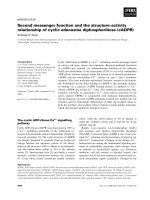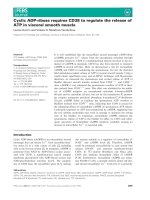The parameter-dependent cyclic inequality
Bạn đang xem bản rút gọn của tài liệu. Xem và tải ngay bản đầy đủ của tài liệu tại đây (782.44 KB, 4 trang )
<span class='text_page_counter'>(1)</span><div class='page_container' data-page=1>
VNƯ Joumaỉ of Science, Mathematics - Physics 23 (2007) 155-158
The parameter-dependent cyclic inequality
Nguyen Vu Luong*
<i>D epartm ent o f M athem atics, M echanics, Informatics, C oỉlege o f Science, VNU </i>
<i>334 Nguyen Trai, Hanoi, Vieínam</i>
Received 15 N ovem ber 2006; received in revised fo rm 12 September 2007
A b s t r a c t . In th is paper we w ill construct a parameter-dependent c y c lic in e q u a lity that can
be used to prove a lot o f hard and interesting inequalities.
1. In tro d u c tio n
T he cyclic inequality is a type o f inequality that may be right in ju s t som e particular cases but
not in genenal. In this paper, vve propose one type o f param eter-dependent cyclic inequality from a
special inequality. Thanks to this inequality, we can obtain many inequalities by choosing
<i>a</i>
and n.N ote that it can be proved by some vvays in particular case. Hovvever in order to prove it in general
case, w e have to use the method that is mentioned in the paper.
2. T h e g en eral case
Denote
<i>R + = {x</i>
€<i>R x ></i>
0}.L e m m a 1.1.
<i>Assume thai Xi</i>
6<i>R, </i>
<i>(i</i>
= l , n )<i>we have</i>
1<b><</b>
<i>Proof. v /e have</i>
l < i < j < n l < i < j < n
<i>Tl\ Tl</i>
— 1 )Since 1 + 2 + --- | - ( n - l ) = — hence the num ber o f term s o f <sub>1 </sub><i><sub><i<j<nx ' x j</sub></i>
<i>OOịOC</i>
7 1S<sub> IS </sub>n ( n — 1)<sub>2</sub>It íịllovvs
</div>
<span class='text_page_counter'>(2)</span><div class='page_container' data-page=2>
156 <i>Nguyen Vu Luong / VNU Journal o f Science, Mathematics - Physics 23 (2007) ì 55-158</i>
Adding both sides o f the above inequality by 2
<i>(n —</i>
1) 5Z i< i< j< n<i>x *x j></i>
we obtain the inequality aswas to be proved.
The proof o f Lemma 1.1 is complete.
<i><b>Theorem 1.1. Assume thai </b></i>
<i>Xi </i> <i>( i </i> <i>—</i><b> l,n ), </b>
<i>n</i><b>> </b>
3<i>are positive </i>
<i>nu m b er. </i><i>Then íhere holds the </i>
<i>following inequaỉity</i>
<i><b>X\ </b></i> <i><b>X2</b></i>
+ --- :— 7--- --- T + --- +
Xi + or(rc2 + • • • +
<i>C n X k +</i>1 )
<i>x 2</i>+ a(a
;3 + --- b
<i>C n X k + ĩ )</i><i>+ . . . + __________ ĩ s . __________ > _ _____ 2n _____</i>
<i>x n</i> + a ( x i H--- 1- <i>CnXk)</i> 2 + <i>a ( n -</i> 1)
<i>Where</i>
<b> Cn = ——rará </b>
<i>k =</i><b> ử </b>
<i>and a is an arbitrary real number satisfies a</i><b> > 2.</b>
<i>Proof.</i>
First, for the sake convinience, we set~
<i>x 2</i>
<i>p —</i> --- ---1- -- 4 -
<i><b>---Xi</b><b> + a ( x 2 H---b CnXk+1 ) </b></i> <i><b>x 2</b><b> + a ( x 3 H---+ c n Xk+2)</b></i>
^
2ĩl
x n + a ( i i H--- h C n i f c ) 2 + a ( n - 1 ) '
Now let’s consider the case n =
<i>2k</i>
+ 1 it givesX?
<i>x \</i>
______________ í______________ I_______________
<i>i</i>
---1_<i>xỊ + a(x ix 2 H--- h X iifc + i) </i>
<i>xị + a(x</i>
2X
3H---- + Z
2Zfc+
2)
x n
. . -I---2--- .
<i>x ị + a ( i„ a ; i H---- + z „</i>
2fc)
p =
Using the fact that
( , , ,
“ í X ,Í=1«»
with ai G i? + (í = Ĩ7n ) , it implies
p > ( E r = i * i) 2
] C i = l <i>Xị + a</i> 5 I l < » < j < n <i>x i x j</i>
Since a ^ 2,it can be rewritten as
<i>a</i>
= 2 +<i>p</i>
with<i>/3</i>
> 0. T his leađs to( / C r = l <i>x i ) 2</i> + <i>0 ^ 2 l < i< j < n x i x j</i>
Applying Lem m a (1.1) w e obtain
(ES-1
_ 2 n
or
<i>p</i>
^ ---7- --- r .</div>
<span class='text_page_counter'>(3)</span><div class='page_container' data-page=3>
<i>Nguyen Vu Luong / VNU Joum al o f Science, Mathematics - Physics 23 (2007) 155-158</i> 1 57
N exụ for
<i>n =</i>
2<i>k,</i>
w e get<i>p =</i>
_________________<i>ĩ ỉ</i>
_________________ , __________________* 2__________________1 1
<i>x ị</i>
+<i>a ( x i x 2</i>
H--- f X ịI* + ^XiXfc+ i)<i>x ị</i>
+ 0 (0:2 2 : 3 H--- + Z2Zfc+l +<i>^X</i>
<i>2</i><i>Xk+ĩ)</i>
„ 2
<i>x n</i>
+ ■■• +
<i>-x ị</i>
+ a ( :r n;ci + • • • + <i>X n X k- 1 </i><i>+ ^ x nx k)</i>
A pplying the inequality (1.2), we get
<i>p ></i>
( S ? I i « o2 .. ( E L i f ị ) !E i- 1
<i>x ị + a</i>
5 Z l< t< j< n<i>x ix j</i>
( H t = l x « ) 2 + /? X à < j< j< n<i>XịXj </i>
U sing the Lem m a 1.1 once more, we come to the following inequality
( E " = 1
<i>x i) 2</i>
_ 2 n* i )2 + z <)2 2 + Q<" 1}
Thus Theorem 1.1 is proved.
3. T h e special cases
For n = 3, w e obtain the following inequalities.
E x a m p le 1.1. Let
<i>a, b, c</i>
be positive num bers, a ^ 2, prove that<i>a </i>
<i>b </i>
<i>c</i>
3+ T— --- ỉ--- :--- ^
<i>a + ab </i>
<i>b + ac </i>
<i>c + a a</i>
l + CKTake a = 2 we obtain
E x a m p le 1.2. Let a ,
<i>b, c</i>
be positive num bers, prove that<i>a </i>
<i>b </i>
<i>c </i>
<i>^</i>
,+ r - r + — V ỉ* 1.
<i>a</i>
+ 266 + 2c
c + 2aTake a
= -ị- ^
2<=>
aò c< ị,
we yieldaoc 2
E x a m p le 1.3. Let a , 6, c be positive num bers satisíy
<i>abc <</i>
prove thata 2c
ố2a
c26
<i>3abc</i>
<i>1 + a2c</i>
1 + ỉ^a ^ 1 +<i>c?b ^</i>
1 + abcFor n = 4 w e yield the inequality
E x a m p le 1.4. A ssum e that
<i>a, b , c , d e R +, a</i>
^ 2, prove thata 6
<i>c </i>
<i>d</i>
42 a + a (2 ố + c) 25 + a ( 2 c + d) ^ 2c + a ( 2 d + a ) 2d + a ( 2 a + 6) ^ 2 + 3 a
Take a = 2 we obtain
E x am p le 1.5. A ssum e that
<i>a, b ,c ,d € R +,</i>
prove that</div>
<span class='text_page_counter'>(4)</span><div class='page_container' data-page=4>
158 <i>Nguyen Vu Luong / VNU Journal o f Science, Mathematics - Physics 23 (2007) 155-158</i>
Take o =
<i>b, b — c</i>
we getE x a m p le 1.5. A ssum e that
<i>a, b</i>
6<i>R +, a</i>
> 2, prove that<i>a ((a</i>
+ 2)a +<i>2ab) </i>
<i>b((a +</i>
2 ) 6 +<i>2aa) </i>
<i>2</i>
[2
<i>a</i>
+<i>a(2a</i>
+ 6)] [2a + 3aò] [26<i>+ a(2b +</i>
a ) ] [26 + 3 a a ] ^ 2 + 3 aFor n = 5 w e yield the inequality
E x a m p le 1.7. G ive
<i>a, b , c , d , e e R +, a</i>
^ 2, prove that<i><b>p _ </b></i>
<i>a </i>
<i>b </i>
<i>c </i>
<i>d </i>
<i>e </i>
5
_ a + a ( 6 + c) 6 + a ( c + d) c + a ( d + e)
<i>d</i>
+ a ( e +<i>a) </i>
<i>e + a (a + b) '</i>
1 +<i>2a</i>
Take c = d = e , t t = 2 w e yieỉd the inequality
E x a m p le 1.8. G iven
<i>a ,b ,c € R +,</i>
prove that<i>a </i>
<i>b </i>
<i>/ </i>
<i>2a + 2c + b</i>
\ 4<i>a + 2b + 2c + b</i>
+ 4c \[ c + 2(c + a ) ] [ c + 2 (a + 6) ] / ^ 5For n = 6 w e yield
E x a m p le 1.9. Given <i>ãị e R + </i> <i>( i</i>
<b>= </b>
1 ,6) , a 5= 2, prove thata i
<i>Ũ2 </i>
<i>Ũ3</i>
ữl +
<i>O t { a ^</i>+
<23 +
<i>2 ữ 4 )</i>a 2
a (a 3 +
<i>a 4</i>+
2 ° 5)
° 3
Qí(a 4 + a 5 +
2 °®)
Ũ4 ữ5 ị ^ 1 2
ĩ
ĩ
ĩ
2 + 5a
0 4 + Q r(ữ 5 + 0 6 + 2 ° ! ^ a 5 ữ ( a 6 + ữ l + 2 ữ 2 ) ữ 6 a ( 0 l + ° 2 + 2 ữ 3 )
Finally, take Qi =
<i>Ũ</i>
<i>2</i> = a, 0 3 = a4 = 6, (25 = a6 =<i>c</i>
and ữ = 2 w e getE x a m p le 1.10. A ssum e that
<i>a, b, c</i>
€<i>R +,</i>
prove thata ( 3a + 36
a + 46 + c ) "*"^(36 + 3c~*~6 + 4c + a ) ~^C( 3 c + 3 a ~ ^ c + 4 a + 6) ^
A ck n o w led g em en ts. T his paper is based on the talk given at the C oníerence on M athem atics, Me-
chanics, and Inform atics, Hanoi, 7/10/2006, on the occasion o f 50th A nniversary o f Departm ent o f
M athem atics, M echanics and Inform atics, Vietnam National ư niversity, Hanoi.
R eferen ces
</div>
<!--links-->









